Let’s face it: if you’re a parent, you already know your child’s imagination doesn't shut down at sunset. In fact, that’s when it truly takes off. The quiet hum of the night, a soft blanket of stars outside the window, and a cozy little tent glowing gently in the corner of their room—it’s no longer just a place to play; it becomes their castle, spaceship, reading nook, or dragon’s den. But in this modern world where sustainability and parenting walk hand-in-hand, that dreamy tent also needs to align with eco-conscious values. That’s where the new wave of eco-friendly and sustainable midnight play tents steps in.
Over the past few years, parents have been making more intentional choices when it comes to what surrounds their little ones. From organic food to bamboo toothbrushes, the desire to reduce environmental impact while ensuring a child’s comfort has become a shared parenting goal. And now, play tents are being reimagined through the same thoughtful lens. So, what exactly is happening in this space? Let’s wander into the canvas-covered world of eco-friendly midnight play tents—and no need to tiptoe, we’re all friends here.
Natural Materials Are Stealing the Spotlight
Gone are the days when synthetic fabrics dominated children's indoor play spaces. Today’s top play tents are celebrating the warm, breathable elegance of natural materials. Think 100% organic cotton, sustainably harvested wood frames, and dyes made from plant-based pigments. These choices aren't just about aesthetics—they are deeply rooted in child safety and environmental responsibility. Parents want to know that their toddler isn’t curling up against a wall made of microplastic-laden polyester.
There’s a growing love for cotton canvas, especially the unbleached kind, for its earthy texture and gentle presence. It's breathable, hypoallergenic, and far less processed, which means fewer harmful chemicals in your home. The soft touch and non-toxic finishes are especially crucial for young children whose skin is extra sensitive and whose imaginations take them face-first into every part of their play tent.
Modular Designs That Grow With Your Child
Trends are shifting away from one-size-fits-all solutions. Parents are now gravitating toward modular and convertible designs that evolve alongside their child's changing needs. That midnight play tent your toddler uses for storytime today might morph into a cozy reading nook for your growing reader tomorrow—or even a mini workspace during craft time.
This adaptability supports sustainable living in a subtle but important way: instead of buying multiple toys and play zones that eventually end up in the donation pile or, worse, the landfill, families are investing in a single high-quality item that serves multiple roles over the years.
Tents that come with adjustable poles, removable curtains, and customizable elements like interchangeable floor mats or reversible patterns are quickly becoming parent favorites. These features let the tent feel new even as the years pass, reducing the need for constant upgrading and promoting a more circular lifestyle.
Gender-Neutral and Nature-Inspired Aesthetics
Today’s parents are steering away from over-saturated pinks and blues, opting instead for gender-neutral, nature-inspired color palettes. Think soft sage, warm beige, muted terracotta, gentle sky blues, and woodland greens. These hues don't just promote a calmer environment, they also reflect the aesthetics of modern, earth-conscious households.
This move is more than just a style preference—it echoes the broader societal embrace of inclusivity, mindfulness, and ecological awareness. The tones mimic the colors of a forest at dusk or the morning dew on fresh grass. When paired with gentle lighting—perhaps a soft string of fairy lights—the result is a dreamy midnight retreat that helps children unwind and encourages imaginative play without the harsh stimulation of loud, artificial colors.
Many sustainable tent designs also incorporate little details that reflect the natural world. Embroidered stars, felted moons, printed trees, or stitched-on animal friends turn each tent into more than a toy—it becomes a miniature universe, connected to nature yet safe inside the walls of your home.
Eco-Friendly Production Processes and Packaging
Let’s talk behind the scenes. What’s making the biggest impact in the eco-friendly play tent movement isn’t just the product—it’s how it’s made. Conscious consumers are digging deeper these days. They're not only asking what materials are used, but also where they come from, how they're processed, and how everything is packaged.
Brands that are leading the charge in this space are reducing their carbon footprints through low-impact manufacturing, using renewable energy sources, cutting down on water usage during production, and minimizing waste. It's about the whole story—not just the pretty tent in your child’s room but the invisible chain of decisions that made it possible.
Packaging is undergoing a green revolution as well. Minimalistic, plastic-free packaging with recycled cardboard and soy-based inks is being embraced. Some even come with packaging that doubles as part of the play experience—like a box that unfolds into a coloring canvas or a foldable tent floor. Less waste, more fun.
Easy Maintenance Meets Longevity
Another rising trend is durability with ease. Because let’s be honest, no matter how beautiful or sustainable a play tent is, if it can’t survive a juice spill or an enthusiastic wrestling match between siblings, it’s not going to make the cut. That’s why parents are now looking for tents that blend eco-friendly craftsmanship with practical, real-life durability.
Enter machine-washable cotton covers, stain-resistant natural dyes, and hardwood poles with easy disassembly. These features make midnight play tents not only sustainable in theory but in practice. A well-crafted tent should be able to move from the nursery to the living room, onto a balcony for stargazing, and maybe even to grandma’s house—all without showing signs of wear and tear.
And let’s not forget—durability extends to emotional longevity too. Children form bonds with their favorite spaces. When a play tent remains in good shape over time, it becomes a comforting constant in their childhood memory scape, a “fort of forever” that means more than any plastic toy ever could.
Conscious Brand Storytelling Is Winning Hearts
It’s not just about the tent anymore—it’s about the brand behind the tent. Parents want to support companies whose values align with their own. They want to know the makers care about both the environment and the children they’re designing for. Transparency in sourcing, giving back to the community, supporting artisan craft, and maintaining ethical labor practices—these all matter now more than ever.
When parents see a story that resonates—perhaps a small business founded by a mom who hand-dyes each tent using plant pigments, or a team working with local weavers to create eco-conscious patterns—it creates a sense of trust and emotional investment. That story becomes part of the product. And when that story champions sustainability, it reinforces the message to their children: caring for the planet is part of our everyday choices.
Midnight Tents as Part of a Larger Eco-System
What’s particularly beautiful about this movement is how midnight play tents are no longer just standalone pieces, but are thoughtfully integrated into a child’s greater environment. Many eco-conscious brands now offer matching accessories—like soft organic cotton floor mats, starry printed pillows, foldable wooden toy chests, or felt garlands. Each of these pieces is designed not only to coordinate in look and feel but also to maintain the same standards of sustainability.
Parents are building entire bedtime worlds around these tents—cozy, low-impact spaces where stories are read under starlight string lights, and where the air smells faintly of clean cotton and not synthetic plastic. These micro-environments encourage mindfulness and spark imagination, all while honoring the natural world.
What’s striking is how these spaces invite participation. Children feel ownership and pride in helping to set up their tents, arrange the cushions, or drape their own tiny scarves as makeshift curtains. It’s a form of gentle parenting by design, promoting autonomy, creativity, and respect for the things we own.
The Rise of Ethical Gifting
Eco-friendly midnight play tents are quickly becoming a favorite for conscious gift-givers. Whether it’s a baby shower, birthday, or holiday surprise, more people are choosing to give gifts that reflect lasting value over flashy trends. And a sustainable tent hits that sweet spot—it’s unique, useful, beautiful, and brimming with meaning.
Parents themselves are often the recipients of this shift too. Grandparents and friends are seeking alternatives to mass-produced plastic toys, and many are delighted to stumble upon these nature-loving little tents that feel more like heirlooms than playthings.
They become keepsakes. Childhood anchors. Gifts that say, "I see your values, and I celebrate them."
Suggested Reading: When Should You Start Using Ultra Absorbent Mats for Your Baby?
In Conclusion: Where Whimsy Meets Responsibility
If you thought sustainable living was all about cutting back and saying no, think again. The world of eco-friendly midnight play tents is brimming with joy, creativity, softness, and warmth. It’s about building childhood spaces that don’t compromise on beauty, fun, or comfort—and that tread gently on the planet too.
What we’re seeing now is a redefinition of play: one that’s as enchanting for children as it is reassuring for parents. It's a movement toward creating nurturing indoor environments that foster wonder while quietly teaching care—care for ourselves, our families, and the world around us.
At the heart of this wave is Happy Matty—a brand that understands how important it is to balance aesthetic charm with sustainability. Their midnight play tents embody everything today’s eco-conscious parent could wish for: organically sourced materials, thoughtful designs, ethical production practices, and a soulful connection to the needs of real families. If you’re on a journey to build a greener, gentler space for your little dreamer, you’ll find the perfect partner in Happy Matty. Visit https://happymattystore.com/ and discover how magic and mindfulness can live under the same canvas roof.



